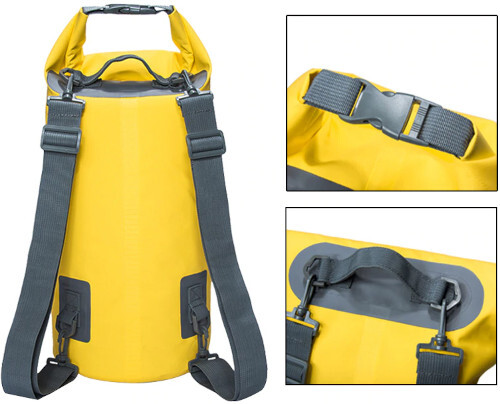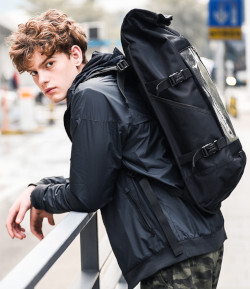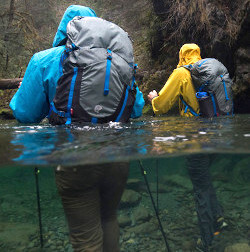Backpacks for Amphibian Adventures
Keeping the contents of your backpack dry even when you don't, is an interesting challenge. With the right concepts and equipment this is easy.
Since not all of your outdoor gear can be waterproof, you may want a waterproof backpack. For short river hikes you can get a completely waterproof backpack to carry your food and drink, a phone, and a change of dry clothes. They are easy to swim with, just float behind you and add some buoyancy. In tricky situations wear your bag in front as a float.

Seen on Aliexpress:
Canoeing and swimming bag US$7 to $20 subject to size.
Sealed backpacks keep your kit dry. Choose the robust ones used for canoeing. They can cope with frequent immersion and provide extra buoyancy.
Size
The size of your backpack depends on the length of your trip.
A small day pack with snacks, a change of clothes and a bin liner is all you need for a day in the rain or water.
For overnight trips you may want to carefully plan your kit.
Keep you bag content minimal.
Day Packs
If you only venture out for a day, a waterproof day pack might be useful. In it you keep your food and a change of clothes for after your excursion. Protect your stuff from water, sand and dust during river trekking, drifting, swimming and beach leisure. A small waterproof bag inside keeps your wallet and car keys dry.
If you keep a change of clothes waiting for you in your car, then the clothes in your day pack let you dry out for a lunch break, while your wet clothes can drip dry a bit.
After your lunch break, you pack away the wet kit as it's not nice to put on clammy clothes.
Instead you wear your dry clothes for the way back, ready to get wet,
since you have a dry set in your car.
Submersible Dry Bags
A few manufacturers offer waterproof submersible bags that you can carry into the water. They can be completely sealed and stay dry when you go into the water. A good backpack has a hip belt that distributes the weight further down to reduce shoulder load.
Some backpacks, like the Rain Shadow Outdry, claim to be completely waterproof, so you can use them for river hiking. Waterproof and floating, they keep your items inside dry, while keeping dirt or sand out.

While your hiking clothes get wet, your bag contents stay dry.

Mountain Hardwear Rainshadow Outdry Backpack has many features of a regular backpack, but is waterproof.
Make Your Own Waterproof Bag
Some intrepid hikers go backpacking in rivers for several days. This requires certain skills to pack and waterproof your backpack. For the night you need dry clothes, food, and a small tent or bivy bag.
Backpacks made out of waterproof fabric are fairly useless because they leak at the seams after a while. You can build your own waterproof adventure backpack system. This costs less, but might weigh more.
Just to be perfectly clear, a backpack is NOT always waterproof. If you take your pack for a swim, it’s going to fill up with water, less so if stuffed with waterproof canoeing bags.
Pick a robust backpack and fill it up with water. If the water leaks out quickly, that's good as it will drain fast after immersion. This works well if you're crossing rivers or lakes and you have to swim a bit.
Drain Holes
Some backpacks already have tough drain holes, so that any water that gets into your pack will immediately drain out the bottom. Otherwise you may have to put some drain holes into the bottom, or get it done by a skilled craftsman. Stitch them up well so they don't rip into larger holes and your stuff falls out. The whole point is to drain off the water quickly and keep the weight low when you come out of the water.
Dry Stuff
Everything that MUST stay dry goes into the above mentioned waterproof canoeing bags, like your food, tent, sleeping bag, a change of dry clothes, and your gadgets and batteries. Leave another dry set of clothes in the car for your way home. Anything else you wear in the water or attach to the outside.
To seal the bags, align the top stiffener bands and fold the top down 3-4 times. Do not push all the air out of the bag. It will provide positive internal pressure to better seal the opening. Then close the buckle and put the bags into your backpack.
Wet Stuff
Things that can get wet, go directly into your backpack, like tent poles, your poncho, rain pants, and such.
Wear any clothes that can get wet to reduce the weight of the backpack.
When you cross a slow moving river or swim across a lake, the clothes you wear and the inside of your bag will get wet, but your essentials stay dry.
This backpack also makes a good float to hang on to as the bags inside will create sufficient floatation.
Carry Tips
Every time you take a break at a suitable place along the river, check your backpack.
As you go along you'll learn different ways to carry your backpack.
If your bag is not fully waterproof it is best to carry it over your head.
If it is waterproof, you may prefer to carry it on your back,
as this gives you more buoyancy and keeps your hands free.
Backpack Rain Cover with a Hood
Without a hood, pack covers are fairly useless. They only cover the outside of your backpack, not the area between the shoulder straps. Rain water runs down your back and into your rucksack. That's why you need a hood on your cover.
A dry pack with dry contents is good. But, when it’s pouring with rain, you want to keep your back panel and head dry, too. For such occasions, a hooded pack cover is really good. Light and compact, it stows in itself-contained storage pouch.
From light showers to heavy rain a waterproof cover delivers fast and efficient protection with an adjustable hood for your head and shoulders, and extended cover for your rucksack. It neatly fits into an outer pocket of your backpack when not in use.
This compact rain cover for day packs and rucksacks up to 40 litres
prevents the rain water from seeping through the gap between your back and your rucksack,
thus keeping the both dry from all directions unlike regular rain covers.
If you do not wish to use the hood, you can simply roll it in and just use the pack cover.
Adjust to the Weather
When it is too warm for a raincoat, this backpack cover comes in handy. While you enjoy the rain, you don’t want all of your gear to get wet. In hot and humid weather the hood covers your head and pack while you let your clothes get wet in the rain and keep you refreshed.
During drizzling conditions you don't actually need a raincoat if you have this cover. In windy weather you may want to wear your backpack on top of your rain clothes, otherwise underneath your hiking cape or poncho.
We've all been in that scenario, you just finished heard the rumbling of thunder so you hurry and scramble in your pack and pull out your fly to protect your pack and in the heat of the storm you get pounded and pounded with rain. Water starts going down your back, your face is drenching, and this hike out just turned from a beautiful stroll in the park to a wet, miserable mess.
The great thing about the Hooded Pack Fly is that with the built in hood, and the material being connected,
it forms a shield around the pack and your head keeping you dry and your gear protected no matter what weather.
This works awesome and is a must have for anyone who owns a Mystery Ranch Pack!
Key Benefits
- Keeps head, shoulders, and backpack dry
- Weighs only 150 grams and packed size is 15 x 15 x 8 cm
- Made from PU coated Polyester fabric
- Fully heat taped seams for excellent waterproofing
- Does not hinder swimming
Reader Comments
My stuff stays dry while I get wet
by Dylan from Cork in IrelandThis hooded pack cover is a great product. Period. Very thoughtful design and more importantly it does work! Just before my 3 months long India trip I bought this backpack cover. It was during the month of June, July and August I did this trip through Kerala, Hampi and along the Konkan coast. It was the monsoon time!
Since I had this backpack cover, my 40 litre backpack remained dry throughout the trip. During heavy rains, I would first wear my raincoat and then the backpack with this cover. Not a single drop of water did enter inside my bag!
During drizzling conditions or light rain I didn't wear a raincoat, only this cover. In the hot and humid monsoon weather I prefer to let my clothes get wet from rain, rather than sweat inside a raincoat.
Well, at times it does look a bit strange, a big yellow bulge which isn't actually a raincoat. I was planning to buy a Quechua backpack cover which is almost similarly priced without a hood, but I am totally satisfied with this purchase.
I highly recommend this product and would love to try out other Gipfel products too.
It's great to see an Indian company entering the adventure gear territory and going strong. All the best, guys.
Park Ranger
Report by Nai, Phuket, ThailandPhuket is a wonderful island if you stay away from the tourist traps. Up in the misty rain forest life is beautiful. Mountain trails cross rivers and wind along small lakes. The lush foliage is covered in morning dew or rain drops and smells lovely. It's a warm wet paradise.
From early morning to evening we patrol the rain forest. It rains a lot in our area, mostly in the afternoon when a heavy downpour hits us for one or two hours. While walking the trails, crossing rivers and lakes, we often go into the water fully clothed. This is very refreshing.
Our clothes are very breathable, but not waterproof and get completely soaked in the rain, but the backpack contents always stay dry. Wet clothes dry quickly, but wet food or a wet equipment can cause problems. Waterproof backpacks keep our gear dry and working. They are essential for our work.
When the sun comes out we enjoy a snack break while our clothes quickly dry.
Back at our base we take a shower to rinse our clothes and clean them up.